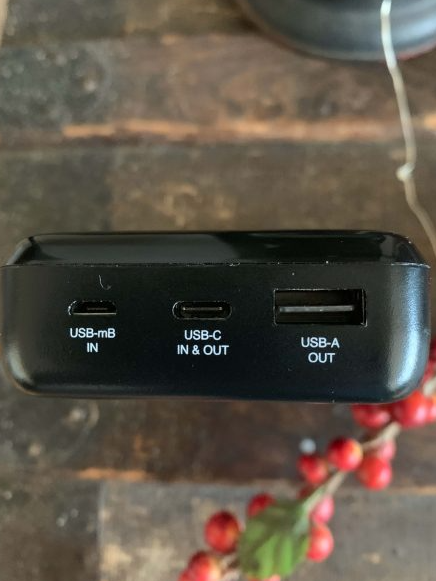Taking The Power Of Accessibility Into Your Own Hands: a Review of the Energrid VS820PD power bank
Read a review about the Energrid VS820PD power bank including a description of how it works with its non-visual vibration feedback.

By Scott Davert, Coordinator: Technology, Research and Innovation Center, Helen Keller National Center for DeafBlind Youths and Adults
August 31, 2022
Introduction
As I integrate more technology into my daily routine, one of the challenges I face is providing power to all of the equipment. Along with my iPhone and braille display, I frequently carry other things that need to stay charged such as the external microphone used with my hearing aids. This device is essential, maintaining my ability to communicate with companions or the general public in complex settings. Recent unofficial support for connecting some braille displays to iPhones over USB is yet another reason to have external power as the adapter requires more power than the iPhone itself can supply. In an increasingly connected world, many others are also using more hardware such as Bluetooth keyboards and headsets in order to maintain or even increase their independence.
Over the years, I’ve tried many external battery packs or “power banks” with varying degrees of success. One issue with most power banks on the market is the flashlights which can be turned on by mistake. As someone with no light perception, this can be problematic if I’m seeking to charge a device only to find the power bank completely drained. Similarly, determining the amount of charge left in the power bank also typically relies on lights on the device. I can use an app to get sighted assistance, fire up a light detector app or consult the nearest sighted person. However, that is not always autonomous, convenient or feasible. When I would only charge one or two different devices on these external battery packs, I could mentally track how much juice I had left to some degree. For example, a 20,000 MAH battery pack would charge my iPhone approximately 6 times from 0%, or up to 8 times if the iPhone’s battery was not fully flat when charged.
As the demand for USB power increases and my technology needs continue to evolve, keeping track of this math is becoming a complex task. The Energrid VS820PD power bank seeks to address some of these issues and a few more I’ll discuss below.
Description
The Energrid VS820PD is rectangular, measuring 5.5 inches long by 2.8 inches wide by 1 inch thick and weighs 13.2 ounces. Its physical profile is larger than other similar power banks because it contains a vibration motor and a device which produces beeps. It features only one button on the upper right corner. On the top surface, there is a smooth area which should be the furthest thing from you. The smooth portion of the surface is a series of lights which flash to give the user the amount of power remaining. A USB-C cable is included with the power bank, but no wall charger. On the front of the device, from left to right, you will find the standard USB-A portused by most legacy devices, a more modern USB-C port for charging an external device or the power bank itself and the Micro-USB port.
How It Works
Setting this battery pack apart from the competition is the audible or tactual feedback for not only determining the level of battery remaining, but also getting confirmation that the device you have plugged in is charging. For devices such as iPhones, this may not be such a big deal since the iOS device will confirm it’s charging. I have several other devices which will not give this information in an accessible way. If I have no idea how much charge is left on my battery pack, I have no way to know if the device I’ve connected is actually charging or not.
Pressing the button on the upper right corner of the VS820PD gives you the battery status through a series of vibration patterns. If the battery is 0-25% full, you will get a single vibration, 26-50% will produce 2vibrations, 51-75% will vibrate 3 times, and 76-100% will emit 4vibrations. You can also have auditory feedback, which produces beeps along with the vibrations. This is toggled on and off by pressing and holding the button for two seconds. The beep is quite high pitched so may not be useable by those with high frequency hearing loss.
The non-visual feedback doesn’t end there. If your device is charging, you will get confirmation through the VS820PDin the form of beeps or vibrations. These will be delivered in the form of two vibrations and/or two beeps, followed by a pause, and then two more. If connecting a second device, you will receive another confirmation.
When charging the VS820PD, it vibrates once to confirm it is plugged in. You can then press the button to determine how much charge the power bank has. The only drawback to this is that there is no differentiation between the 4 vibrations once the battery bank reaches 76% and when it is fully charged. The lights on the surface of the device do give further feedback as to how much the battery pack is charged by having the 4th light flash instead of a solid light. However, that is the only way this information gets conveyed. Since the vibration motor is clearly able to produce both a short and long vibration, it would be helpful if that could be used to give moreprecise information as to the battery status. If the suggested option of a series of long and short vibrations is not possible, having the power bank emit 5 vibrations to indicate it is fully charged may also work.
Conclusion
At $100, the Energrid Accessible Portable Power Bank and Charger is far from the most economical power bank on the market. The Anker PowerCore 20000 retails for $60 on Amazon. This power bank does not have a flashlight, however it also does not offer the peace of mind of knowing how much charge your power bank has. The above mentioned power bank from Anker, like all other mainstream power banks, provides no non-visual feedback to indicate that a connected device is charging. For the blind or DeafBlind consumer, the question when considering the various options comes down to a healthy balance between affordability and functionality. If you want to spend $69, for example, the Anker PowerCore 26800 which packs 26,800 MAH, may be a strong contender. It not only has a higher battery capacity, but also has the ability to charge up to three devices at a time. Again, though, you will not get the non-visual information about the status of connected devices and approximate battery percentage left onyour power bank. Also worth noting about the higher capacity power bank from Anker is that it weighs 1.1 pounds, so is a bit heavier to carry around.
AT Guys, the reseller of the Energrid VS820PD in the U.S, also sells a thinner and lower-capacity (10,000 MAH) version for $75. For more information, please see the product’s page on the AT Guys website, where you will also find accessible documentation in audio and PDF format.


